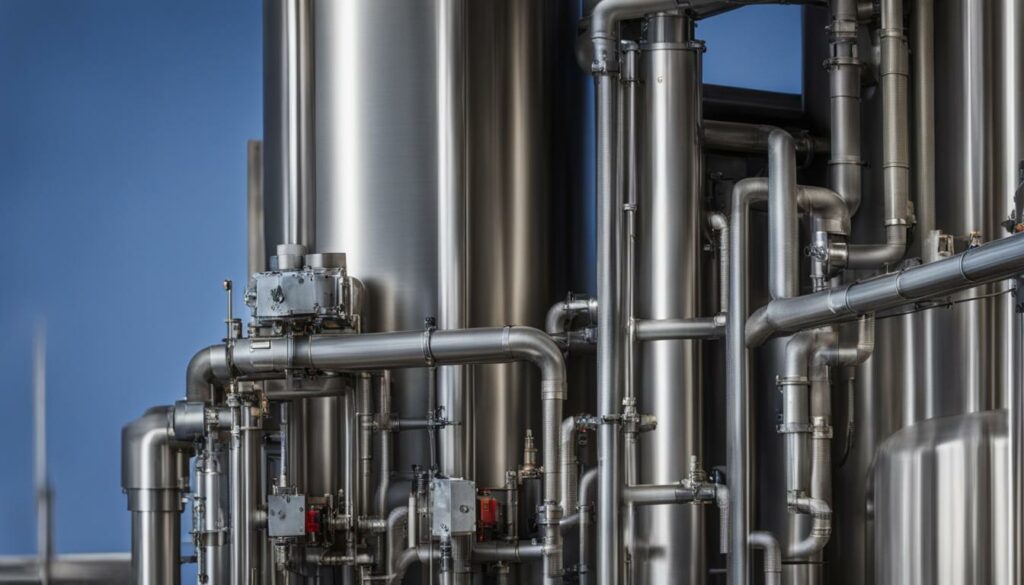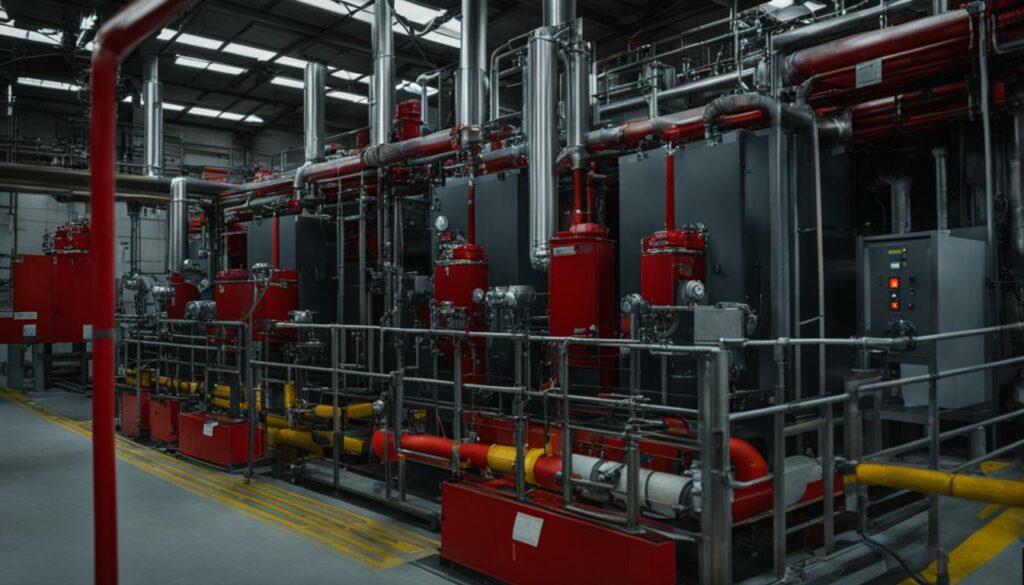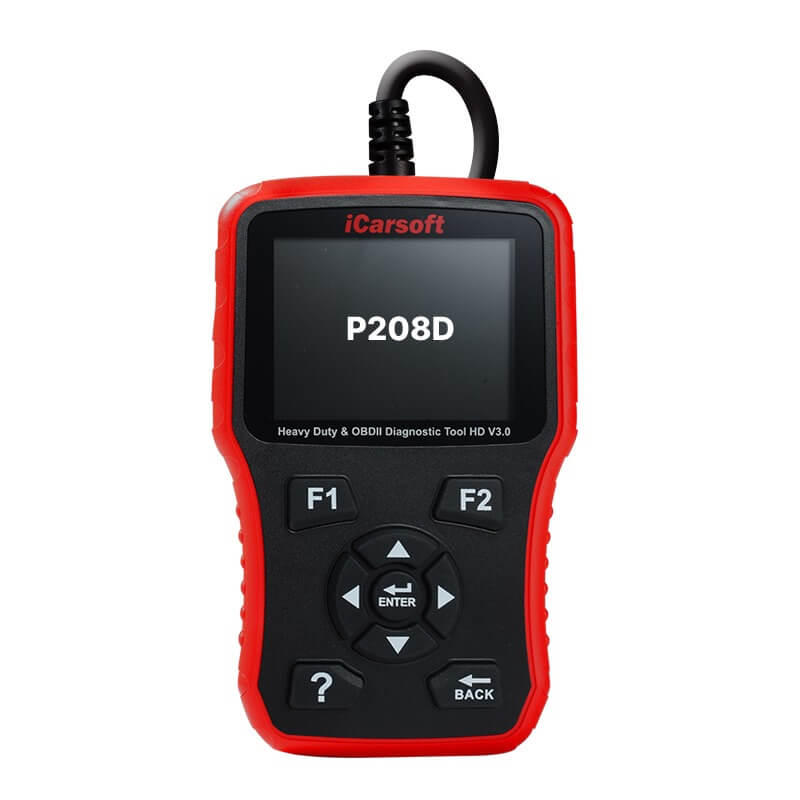P208D – SCR Reagent Dosing Unit Temperature Too High
POSTED IN pcodes
Welcome to our article on the P208D code, which indicates that the temperature of the SCR Reagent Dosing Unit is too high in a diesel engine equipped with a Selective Catalytic Reduction (SCR) system. This code is related to the temperature sensors and the dosing unit responsible for injecting the SCR reagent (often known as diesel exhaust fluid) into the exhaust system to reduce harmful emissions.
When the temperature of the dosing unit exceeds the specified limit, it can lead to inefficient SCR system function and potentially cause engine performance issues. It is crucial to address this code promptly to ensure the proper functioning of the SCR system.
Key Takeaways:
- The P208D code indicates that the temperature of the SCR Reagent Dosing Unit is too high in a diesel engine equipped with an SCR system.
- The code is related to temperature sensors and the dosing unit responsible for injecting the SCR reagent into the exhaust system.
- An excessively high temperature in the dosing unit can lead to inefficient SCR system function and engine performance issues.
- Promptly addressing the P208D code is essential to ensure proper SCR system functioning.
- Regular maintenance of the dosing unit can help prevent issues like P208D.
Symptoms of P208D – SCR Reagent Dosing Unit Temperature Too High
The P208D code indicates that the temperature of the SCR Reagent Dosing Unit is too high in a diesel engine equipped with a Selective Catalytic Reduction (SCR) system. Understanding the symptoms associated with this code is essential for timely diagnosis and repair. While specific symptoms may vary depending on the vehicle and engine, there are some common indicators to watch out for.
Check Engine Light Illumination
One of the primary symptoms of the P208D code is the illumination of the check engine light on the vehicle’s dashboard. The onboard diagnostic system detects the high temperature of the dosing unit and triggers a warning signal. It is crucial not to ignore this warning light and have the vehicle inspected by a qualified technician immediately.
Reduced Engine Performance
Another symptom of the P208D code is potentially reduced engine performance. The excessive temperature in the dosing unit can negatively affect the efficiency of the SCR system, leading to compromised engine performance. Drivers may experience a decrease in power output, sluggish acceleration, or overall poor engine responsiveness.
Buy tested tuning file for Adblue / EGR / DPF / Adblue off now!
Reduced Fuel Efficiency
Inefficient operation of the SCR system due to a high dosing unit temperature can lead to reduced fuel efficiency. The engine may consume more fuel than usual to compensate for the compromised emission reduction process. This can result in increased fuel consumption and decreased mileage, impacting the overall cost-effectiveness of the vehicle.
Increased Emissions
High dosing unit temperature can affect the proper functioning of the SCR system, potentially leading to increased emissions. The system relies on the accurate injection of the SCR reagent to reduce harmful pollutants in the exhaust gases. When the dosing unit temperature is too high, the effectiveness of emission reduction may be compromised, resulting in higher emission levels.
It is crucial for vehicle owners to pay attention to these symptoms and take appropriate action. Prompt diagnosis and repair can prevent further damage to the SCR system, ensure optimal engine performance, and help maintain compliance with emission regulations.

| Symptoms | Description |
|---|---|
| Check Engine Light Illumination | The check engine light on the vehicle’s dashboard illuminates as a warning sign of the high dosing unit temperature. |
| Reduced Engine Performance | The engine may exhibit decreased power output, sluggish acceleration, or poor responsiveness due to compromised SCR system efficiency. |
| Reduced Fuel Efficiency | Inefficient operation of the SCR system can lead to increased fuel consumption and decreased mileage. |
| Increased Emissions | The compromised SCR system function can result in higher emission levels due to inadequate emission reduction. |
Common Causes of P208D – SCR Reagent Dosing Unit Temperature Too High
The P208D code can have several common causes, each contributing to the high temperature issue in the SCR Reagent Dosing Unit. These causes include:
- A malfunctioning temperature sensor: A faulty temperature sensor can provide inaccurate readings, leading to a misinterpretation of the SCR system’s temperature.
- A faulty dosing unit: If the dosing unit itself is defective or experiencing mechanical issues, it may result in an increase in temperature.
- A clogged or restricted dosing system: Impurities or blockages in the dosing system can disrupt the flow of the SCR reagent, causing the temperature to rise.
- Issues with the vehicle’s exhaust system: Faulty components or leaks in the exhaust system can affect the proper distribution and mixing of the reagent, leading to temperature abnormalities.
- A malfunctioning engine control module (ECM): A faulty ECM can cause incorrect calculations and control of the dosing unit temperature, resulting in elevated readings.
- Wiring issues: Damaged or loose wiring connections between the temperature sensors, dosing unit, or ECM can interfere with accurate temperature measurements and control.
To accurately diagnose the underlying cause of the P208D code, it is essential to conduct a thorough inspection and perform necessary tests on the temperature sensors, dosing unit, dosing system, exhaust system, ECM, and wiring connections. Identifying and addressing the specific cause will enable the appropriate repairs or replacements to be carried out, bringing the dosing unit temperature back within the desired range.
| Cause | Description |
|---|---|
| Malfunctioning temperature sensor | A faulty temperature sensor can provide inaccurate readings, leading to misinterpretation of the SCR system’s temperature. |
| Faulty dosing unit | A defective or malfunctioning dosing unit can contribute to the increase in temperature within the SCR Reagent Dosing Unit. |
| Clogged or restricted dosing system | Impurities or blockages within the dosing system can disrupt the flow of the SCR reagent, resulting in temperature abnormalities. |
| Issues with the vehicle’s exhaust system | Malfunctioning components or leaks in the exhaust system can affect the proper distribution and mixing of the reagent, leading to temperature fluctuations. |
| Malfunctioning engine control module (ECM) | A faulty ECM can cause incorrect calculations and control of the dosing unit temperature, resulting in elevated readings. |
| Wiring issues | Damaged or loose wiring connections can disrupt accurate temperature measurements and control within the dosing unit. |
Troubleshooting Steps for P208D – SCR Reagent Dosing Unit Temperature Too High
If you encounter the P208D code indicating that the temperature of the SCR Reagent Dosing Unit is too high, follow these troubleshooting steps to address the issue:
- Check the temperature sensors: Inspect the temperature sensors connected to the dosing unit for any signs of damage or malfunction. Ensure that they are securely connected and functioning properly.
- Inspect the dosing unit: Examine the dosing unit for any visible issues such as leaks, blockages, or damaged components. Pay attention to the reagent injector and associated hoses.
- Verify the dosing system: Check for any clogs or restrictions in the dosing system that may be causing the high temperature. Ensure that all lines and filters are clear and free from debris.
- Check the exhaust system: Inspect the exhaust system for any leaks or damage that could be contributing to the high temperature. Pay close attention to the area around the dosing unit.
- Test the engine control module (ECM): If all else fails, consider testing the ECM for any potential malfunctions or errors. Consult the manufacturer’s guidelines or seek professional assistance for this step.
By following these troubleshooting steps, you can identify and address the underlying cause of the P208D code, ensuring the optimal performance of your SCR Reagent Dosing Unit.

Dosing Unit Maintenance for P208D – SCR Reagent Dosing Unit Temperature Too High
Regular maintenance of the dosing unit is crucial to prevent issues such as P208D. By following these maintenance tips, you can ensure the optimal functioning of your SCR reagent dosing unit:
- Keep the dosing unit clean: Regularly inspect the dosing unit for any signs of buildup or contamination. Clean the unit using manufacturer-recommended cleaning agents and procedures. This helps prevent clogs and blockages that can lead to high temperatures.
- Check temperature sensors: Periodically inspect the temperature sensors connected to the dosing unit. Ensure they are clean, properly connected, and functioning correctly. Faulty temperature sensors can provide inaccurate readings and trigger the P208D code.
- Inspect the dosing system: Check the dosing system components, such as the pump and injectors, for any signs of wear or damage. Replace any faulty or worn-out parts promptly to maintain proper reagent dosing and temperature control.
- Monitor reagent quality: Use high-quality SCR reagent (diesel exhaust fluid) that meets the manufacturer’s specifications. Contaminated or poor-quality reagent can cause issues with the dosing unit and temperature control. Ensure the reagent storage tank is sealed and protected from contamination.
- Follow manufacturer’s recommendations: Consult your vehicle’s manual or contact the manufacturer for specific maintenance guidelines and intervals for the dosing unit. Adhering to these recommendations helps maintain the longevity and reliability of the dosing unit.
Proper dosing unit maintenance plays a vital role in preventing the P208D code and ensuring the efficient operation of your SCR reagent dosing system. By implementing these maintenance practices, you can mitigate the risk of temperature-related issues and optimize the performance of your diesel engine.
| Maintenance Tips | Benefits |
|---|---|
| Regular cleaning of the dosing unit | Prevents clogs and blockages |
| Checking temperature sensors | Ensures accurate temperature readings |
| Inspecting dosing system components | Maintains proper dosing and temperature control |
| Monitoring reagent quality | Prevents issues from contaminated reagent |
| Following manufacturer’s recommendations | Ensures proper maintenance and longevity of the dosing unit |
“Regular dosing unit maintenance is essential for preventing temperature-related issues and maintaining optimal SCR system performance.”
Conclusion
In conclusion, the P208D code indicates that the temperature of the SCR Reagent Dosing Unit in a diesel engine equipped with a Selective Catalytic Reduction (SCR) system is too high. This can have a significant impact on the system’s efficiency and overall engine performance. It is crucial to promptly address this code by troubleshooting and implementing the necessary repairs or replacements to ensure the proper functioning of the SCR system.
To prevent issues like P208D in the future, regular dosing unit maintenance is essential. Following the manufacturer’s recommendations and conducting routine inspections can help identify and address any potential problems before they escalate. By taking proactive measures, you can maintain optimal engine performance and minimize the risk of damage to the SCR system.
If professional assistance is unavailable or if you are looking for alternative solutions, it is worth exploring the possibility of permanently removing the code. However, it is important to note that this should only be done after careful consideration and consultation with experts in the field. Always prioritize the long-term health and functionality of your vehicle’s SCR system.
FAQ
What does the P208D code mean?
The P208D code indicates that the temperature of the SCR Reagent Dosing Unit is too high in a diesel engine equipped with a Selective Catalytic Reduction (SCR) system.
What are the symptoms of the P208D code?
Common symptoms include the illumination of the check engine light, potential reduction in engine performance, reduced fuel efficiency, increased emissions, and possible decrease in power output.
What are the common causes of the P208D code?
The common causes of the P208D code include malfunctioning temperature sensors, faulty dosing units, clogged or restricted dosing systems, issues with the vehicle’s exhaust system, malfunctioning engine control module (ECM), or wiring issues.
What are the troubleshooting steps for the P208D code?
To troubleshoot the P208D code, conduct a thorough diagnosis to identify the specific cause. This may involve inspecting and testing temperature sensors, checking the dosing unit and its components, examining the dosing system for clogs or restrictions, and inspecting the vehicle’s exhaust system. Additionally, checking the engine control module (ECM) and wiring connections is recommended.
How do I maintain the dosing unit to prevent the P208D code?
Regular maintenance of the dosing unit is crucial to prevent issues like the P208D code. This includes following the manufacturer’s recommendations for service intervals, inspecting and cleaning the dosing unit and its components, ensuring proper fluid levels, and checking for any signs of damage or leaks.
What should I do if I cannot address the P208D code myself?
If you are unable to address the P208D code yourself, it is recommended to seek professional assistance. A trained technician will have the necessary tools and expertise to diagnose and repair the issue with the SCR Reagent Dosing Unit. They can ensure that the SCR system is functioning properly and help prevent further engine performance issues.


